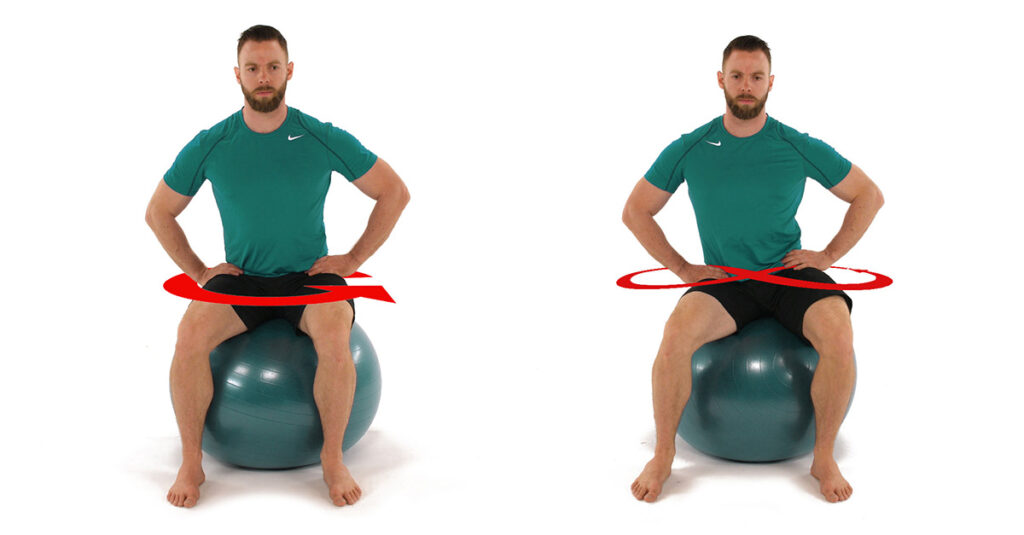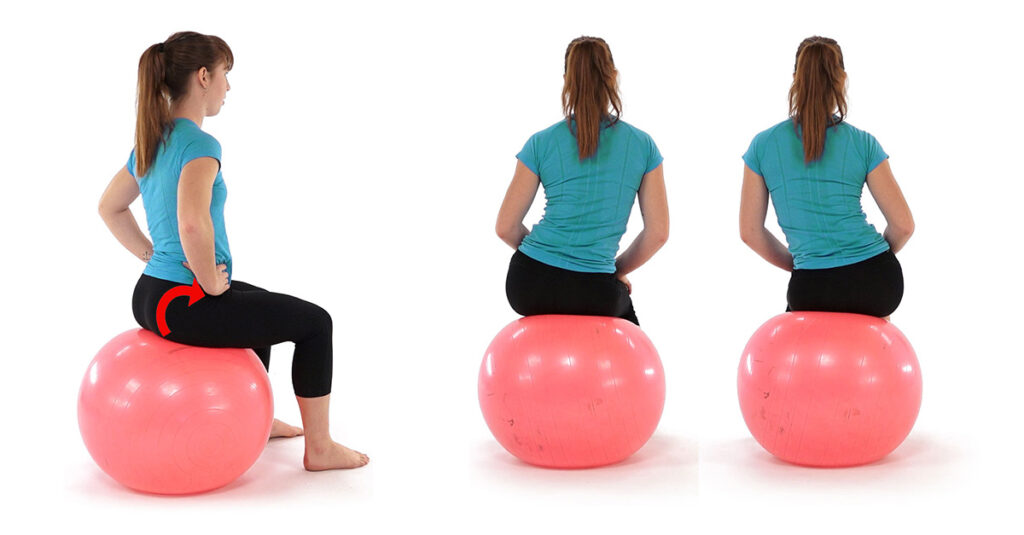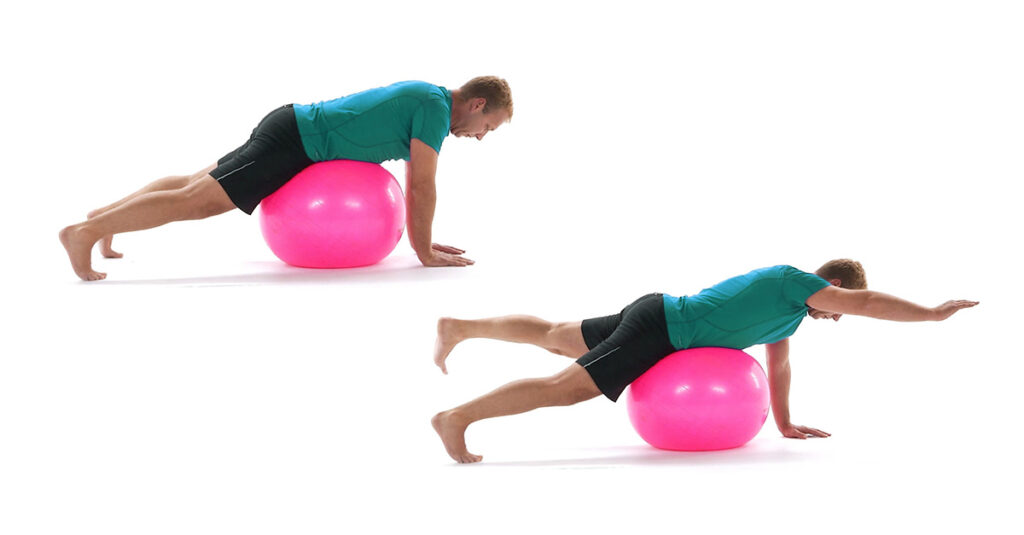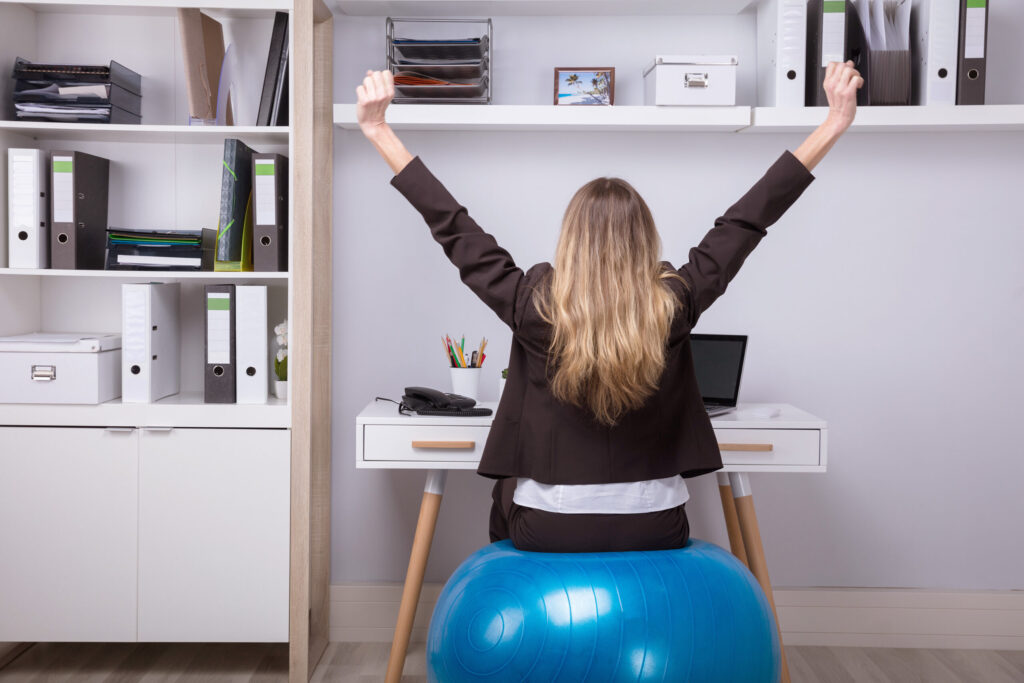Replacing your office chair with an exercise ball can have a significant impact on long-term health.
Here are 5 reasons why exercise ball offers an ergonomic alternative to conventional office chairs:
- Improve your posture and reduce your lower back pain: Sitting on a ball will automatically make your back straight and align the body. That reduces pressure on the spine and prevents chronic lower back pain often associated with poor posture1
- Increase in mobility: Moving the hips becomes easier while seated on a ball: such movement is ideal for people with stiffness in the pelvic area2
- Better balance and concentration: The ball is an unstable surface that constantly engages the core muscles and stabilizers. Studies have shown that sitting on a ball while working or studying improves concentration, thereby increasing productivity at work (or in school for students)3
- Stress management: Movement reduces stress. Imagine bouncing on a ball: it’s a guaranteed moment of stress relief!
- Add exercises to your day: Sitting on a ball allows you to incorporate simple exercises during your workday. Our kinesiologists team at Quatuor MD can show you fun and easy exercises to do on a ball4
Tips
- Make sure to pick the right size of the ball: your knees should be at 90 degrees while seated on the ball.
- Refrain from sitting on the ball for too long as your arms and back are not supported.
- Ideally, try to alternate with a chair every 20 to 30 minutes. Sitting for too long is bad, so that allows you to get up more frequently.
- Take advantage of the ball to do simple exercises or stretches during your workday5.
- If you find it challenging to perform your tasks while seated on a ball, then simply use it to incorporate some exercises for 10 to 20 minutes.
Enjoy a relaxed and colorful work environment with the ball!
Exercises

Exercise 1: Pelvic rotation
- Sit on a ball with your thigh parallel to the ground, your feet flat on the floor and your back in a neutral position (slightly arched).
- Activate your lower abdominals (transversus abdomini) by bringing your belly button inward and by activating your pelvic floor muscles 20 to 30% of maximal contraction.
- Maintain a steady abdominal breathing while you move your pelvis in circular motion, keeping your shoulders and your torso completely still. You can also vary this movement by following the figure of an 8 rather than a circle.
- Repeat.

Exercise 2: Anterior and lateral pelvic tilt
- Sit on a ball with your thigh parallel to the ground, your feet flat on the floor and your back in neutral position (slightly arched).
- Activate your lower abdominals (transversus abdomini) by bringing your belly button inward and by activating your pelvic floor muscles (inner thigh) 20 to 30% of maximal contraction.
2 options:
- Anterior pelvic tilt: Maintain a steady abdominal breathing while you arch your back by rolling the ball backward. Return to the neutral position and repeat.
- Lateral pelvic tilt: Maintain a steady abdominal breathing while you move your pelvis to one side and then the other, keeping your shoulders and your torso completely still. Repeat.

Exercise 3: Abdominal crunch
- Lean back with the ball under your lower back, your knees and feet together and hands behind your head.
- Engage your core by recruiting your pelvic floor and transverse abdominis.
- Raise your upper back off the ball. Hold as recommended.
- Lower and repeat 10 times.

Exercise 4: Oblique Crunch
- Put your lower back on a swiss ball and your hands on the side of your head.
- Drop your upper back and hips down around the ball.
- Lift the upper body and hips to crunch and rotate to one side.
- To increase the difficulty, put your hips more toward the top of the ball.
- To decrease the difficulty, put your upper back more toward the top of the ball.
- Repeat 10 times.

Exercise 5: Superman stabilization
- Lie with your stomach over a ball while stabilizing yourself with your feet and arms. Your back must be straight, but not arched and your chin must be tucked in.
- Activate your lower abdominals (transversus abdomini).
- Maintain a steady abdominal breathing while you lift one foot off the floor and then the opposite arm, keeping your back in neutral position.
- Return to the initial position and repeat with the opposite arm and leg.
- Your back must stay straight and stable at all times.
- Repeat 10 times.

Exercise 6: Forward lumbar flexion
- Sit on a chair and bend at the hips towards the floor to roll the ball forward and stretch the lower back.
- Hold the position for 15 to 30 seconds.
1Exercise ball therapy for lower back pain relief, Thomas Hyde, Peer reviewed Nov.2010
2Sitting for too long, moving too little: regular muscle contractions can reduce muscle stiffness during prolonged periods of chair-sitting; Alexander R. Kett, Thomas L. Milani, Freddy Sichting; Front Sports Act Living, 2021; 3:760533
3Stability balls and students with attention and hyperactivity concerns: implications for on-task and in-seat behavior; Alicia L. Fedewa, Heather E. Erwin; The American Journal of Occupational Therapy, 2011, Vol. 65(4), 393-399
4Evaluating abdominal and lower-back muscle activity while performing core exercises on a stability ball and a dynamic office chair; Michael W. R. Holmes, Diana E. De Carvalho, Thomas Karakolis, Jack P. Callaghan; Hum Factors 2015 Nov; 57 (7): 1149-61
5Effect of stretching program in an industrial workplace on hamstring flexibility and sagittal spinal posture of adult women workers: A randomized controlled trial; Muyor, José M., Lopez-Minarro, Pedro A., Casimiro, Anotnio J.; Journal of Back and Musculoskeletal Rehabilitation, vol 25, no. 3, pp. 161-169, 20212



